 To everything there is a season, and a time for every purpose under heaven. Or, as the Geneva Bible – the bible our heroes and heroines in Lexington would have read: To all things there is an appointed time, and a time to every purpose under the heaven.
To everything there is a season, and a time for every purpose under heaven. Or, as the Geneva Bible – the bible our heroes and heroines in Lexington would have read: To all things there is an appointed time, and a time to every purpose under the heaven.
Remember, the New Englanders were all farmers. They may have done other things as well, like Isaac Davis in Action, who was a blacksmith, or Nate Mulliken who was a clock maker. But everyone at least had a farm to feed their family. Lexington also supplied a good deal of milk and milk products to Boston and Cambridge.
We can even look through old tax records to see what sort of farms they had, how many acres, the types and numbers of animals they had. It was unusual for a family to own one single parcel of land. Usually, they owned grazing land, orchard land, woodlot land; all separate pieces in separate places.
The Estabrooks farmed for a living. They had a lot more going on farm-wise than the Fiske family.
In 1771, the Estabrook farm was made up of 92 total acres. They had 5 horses, 4 oxen, 8 cows, 1 pig and 9 sheep. Only 1 voter in this household.
In 1771, the Fiske family (Joseph Fiske was the town doctor) owned a total of 64 acres. They had 2 horses, 5 cows, 2 sheep, and 1 pig. They had 1 house and there were 2 voters in the household.
April 1775 was a mild April. Spring was in full swing. The farmers were plowing their fields – which was convenient when they decided to hide firearms in the new furrows. The sheep had just been sheared so the womenfolk, in addition to their usual chores, were cleaning wool for carding.
Everyone in the family had a job. The toddlers played while older sibblings watched them. Littles fed the chickens and collected eggs. Pre-teens and teens helped moms and dads with the real work of the day.
No one really had time for a Revolution.
